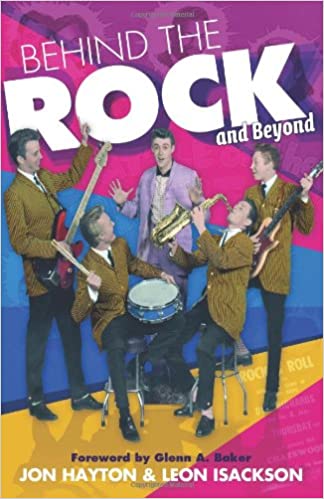
- Free Article: No
- Contents Category: Music
- Custom Article Title: Jay Daniel Thompson reviews 'Vanda and Young' by John Tait and 'Behind the Rock and Beyond' by Jon Hayton and Leon Isackson
- Review Article: Yes
- Online Only: No
- Book 1 Title: Vanda and Young: Inside Australia’s Hit Factory
- Book 1 Biblio: New South, $34.95 pb, 240 pp, 9781742232171
- Book 2 Title: Behind the Rock and Beyond: The Diary of a Rock Band, 1956–1980
- Book 2 Biblio: Sid Harta Publishers, $34.95 pb, 551 pp, 9781921642289
- Book 2 Cover Small (400 x 600):

- Book 2 Cover (800 x 1200):

- Book 2 Cover Path (no longer required): images/ABR_Social/51VKChAOj9L._SX322_BO1,204,203,200_.jpg
At times, Tait’s book reads like an extended fan letter to Vanda and Young. Tait describes the pair as ‘national treasures’ and ‘great all-rounders of the international music industry’. In the chapter on Flash and the Pan, Tait abandons his narrative and provides lengthy accounts of this act’s albums. These accounts contain such laudatory lines as the following one: ‘Another track, “Restless”, has a hypnotic effect on the listener with its Middle Eastern-inspired rhythm and minimalist lyrics.’ Tait might have skills in music reviewing, but this book is not the place to rehearse those skills.
While there is no doubt that Vanda and Young were versatile, I dispute Tait’s assertion that they were ‘rapping before rapping was invented’. Rap music has a long history, particularly within African American culture; it did not originate in the 1960s songs of Anglo-Saxon men. Tait boasts that Vanda and Young have ‘written train songs, car songs, coming home songs, drinking songs, epic songs …’ This is true, but they were not the only Australian songwriters to release such a diversity of tunes (witness Cold Chisel, among many other acts).
Behind the Rock and Beyond is an updated version of Behind the Rock: The Diary of a Rock Band 1956–66 (1990). The book consists of diary entries and reminiscences by the musicians Jon Hayton and Leon Isackson. This pair achieved popularity in Australia during the late 1950s and early 1960s as members of the band Dig Richards and the R’Jays. In 1964 the R’Jays metamorphosed into the Rajahs, the backing group for the dynamic and hugely successful Johnny O’Keefe.
The original Behind the Rock ended in 1966, after the Rajahs had returned to Australia from entertaining troops in Vietnam. Behind the Rock and Beyond contains an account of Hayton and Isackson’s achievements from 1966 to 1980. This account is written mostly by Isackson (Hayton died in 1995). Isackson recalls a second trip to Vietnam in 1968, the changing line-up of the Rajah’s, and Isackson’s work with The Delltones, another popular Australian vocal group.
As with Vanda and Young, Hayton and Isackson’s book is best read as an overdue homage to men who contributed to Australian rock music during its formative years, but who have never achieved major fame. There are some fascinating anecdotes about Isackson, Hayton and the various entertainers they collaborated with. For example, Hayton recalls O’Keefe’s ‘respectability period’, in which he donned ‘an immaculate dinner suit’ and tried to ‘prove to the establishment that he was not merely one of those illiterate, gross rock’n’rollers’. Hayton also recalls collaborating with George Lazenby in the early 1960s. At this point, Lazenby (who would later achieve notoriety playing James Bond) was ‘only a 002, licensed to sell cars in Canberra and sit in on bass with visiting bands’.
Behind the Rock and Beyond would have benefited from firmer editing. Hayton and Isackson undoubtedly wanted to convey the excitement and hedonism that came with belonging to popular Australian bands. Yet they could have chosen more sophisticated ways to express this than by ending most of their sentences with exclamation marks. The names of rock acts are written in capital letters. This looks ugly, particularly on those pages which contain long lists of acts.
A key feature of both books is their masculine bias. In Vanda and Young, female artists are mentioned only occasionally. In Behind the Rock and Beyond, there is an account of the pianist Winifred ‘Winnie’ Atwell’s work with the Rajahs. Atwell is another undervalued figure in music history, both within and outside Australia, and Hayton and Isackson are to be commended for paying homage to her talent. Less commendable is the way in which these men portray other women as sexual objects. For example, this is Hayton’s description of how he avoided being prosecuted for having sex with a minor during the early 1960s:
It seemed, that after all my agonizing, hanging out on a limb waiting for a verdict, all she had to say in the dock was, ‘I TOLD HIM THAT I WAS EIGHTEEN!’ Mind you, the make-up and grown-up clothing helped a little as well!
Later in the book, Isackson describes the ‘versatile vagina’ of an exotic dancer he encountered during his 1968 visit to Vietnam. The 1960s are long over, but Isackson still seems to cling to a very blokey – and very clichéd – fantasy of ‘sex and rock and roll’.
Both texts are highly detailed, but they each contain stories that are underdeveloped. For example, in Vanda and Young, there is a touching anecdote about Vanda’s wife, Pamela. Vanda felt his popularity would suffer if knowledge of their marriage became public. Pamela ‘didn’t want to share her … husband with anyone else’. She suffered depression following the birth of their son in 1966 and died shortly afterwards of a drug overdose. Tait concedes that Pamela’s untimely death ‘would very nearly tear [The Easybeats] apart’. He does not acknowledge that her demise highlights the strain that fame can have on an artist’s loved ones. Indeed, it is questionable how important Tait considers Pamela to be, given how briefly she is mentioned.
Vanda and Young and Behind the Rock and Beyond will be most appreciated by fans of Australian rock music released during the 1960s and 1970s. These readers will be entertained by the extensive accounts of that lively period in Australian musical history, and may excuse the flaws that appear in both books.


Comments powered by CComment